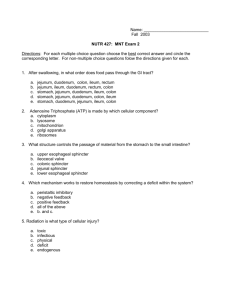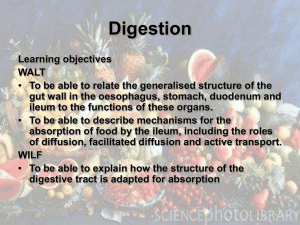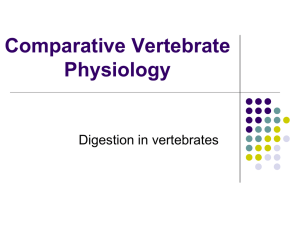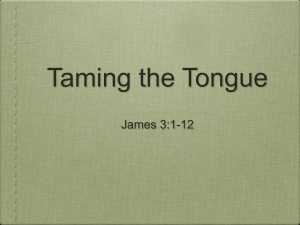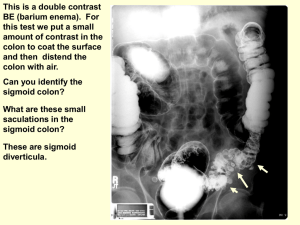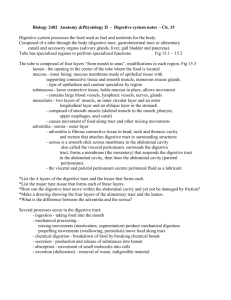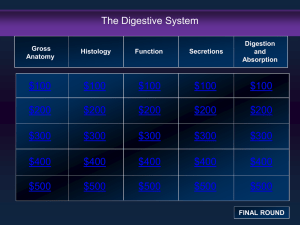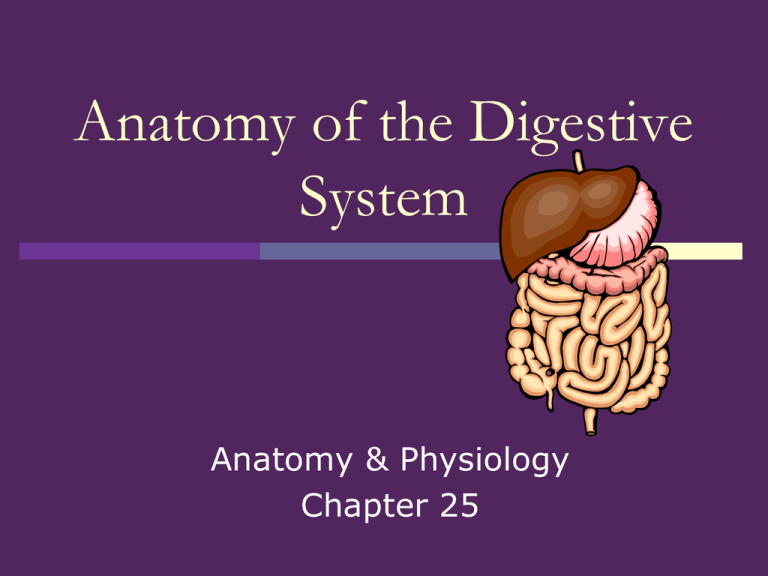
Anatomy of the Digestive
System
Anatomy & Physiology
Chapter 25
Function
Altering the chemical & physical
composition of food so that it can be
absorbed & used by body cells (digestion)
Organs of the Digestive System
Mouth
Oropharynx
Esophagus
Stomach
Duodenum
Jejunum
Ileum
Large Intestine
Cecum
Colon
Ascending colon
Transverse colon
Descending colon
Sigmoid colon
Rectum
Anal Canal
Accessory Organs
Salivary glands
Parotid
Submandibular
Sublingual
Tongue
Teeth
Liver
Gallbladder
Pancreas
Vermiform appendix
Walls of the Gastrointestinal (GI)Tract
Tube with 4
layers of tissue
Mucosa
Submucosa
Muscularis
Serosa
Mucosa
Inner most layer
Made of 3 layers of epithelium, connective
tissue & smooth muscle
Submucosa
Thicker than mucosal
layer
Connective tissue
layer that contains
glands, blood vessels,
nerve plexus
(Meissner plexus)
Muscularis
Thick layer of muscle tissue
Inner layer of circular smooth muscle
Outer layer of longitudinal smooth muscle
Myenteric plexus between the muscular
layers
Serosa
Outermost layer
Made of connective tissue & peritoneum
(visceral layer)
Layer of peritoneum that lines the
abdominal cavity= parietal layer
Mesentery is the fold of membrane that
connects the parietal & visceral layer of
peritoneum
Mouth (Oral cavity)
Lips
Cheek
Tongue
Hard & Soft Palates
Lips
Surround the orifice of the mouth & form
anterior boundary
Covered by skin externally & mucous
membrane internally
Philtrum: shallow vertical groove that
marks the midline of upper lip
Cheeks
Form lateral boundaries, continuous with
lips, lined by mucous membranes
Formed in large part by buccinator muscle
Hard & Soft Palates
Hard palate: consists
of 4 bones: 2 maxillae
& 2 palatines
Soft palate: partition
between mouth &
nasopharynx
Uvula: small cone
shaped process
extending from soft
palate
Tongue
Intrinsic muscle:
changes in size &
shape of tongue;
important for
mastication (chewing)
Extrinsic muscle:
origin outside the
tongue; important for
deglutition
(swallowing) & talking
3 parts: root, body,
tip
Papillae
Vallate: large, form an
inverted V on
posterior part of
tongue; 10-14; taste
buds on lateral aspect
Fungiform: taste buds
on lateral aspect;
mostly on sides & tips
of tongue
Filiform: no taste
buds, over anterior
2/3 of tongue; whitish
appearance
Lingual Frenulum
Fold of mucous
membrane on the
undersurface of the
tongue that anchors
the tongue to the floor
of mouth
Salivary glands
Three pairs:
Parotid
Submandibular
Sublingual
Secrete about 1 L of saliva/day
Parotid Glands
Largest
Between skin &
masseter muscle in
front of & below the
ear
Produce a serous
(watery) type of saliva
Submandibular glands
Mixed gland-contain
both serous & mucusproducing elements
Located below
mandibular angle
Sublingual glands
Smallest
Under the mucous
membrane covering
the floor of the mouth
Produce only a
mucous type of saliva
Tooth
3 main parts
Crown: exposed
portion, covered by
enamel
Neck: area
surrounded by
gingiva
Root: area that fits
into jaw
Tooth suspended
in place by
periodontal
membrane
Tooth structure
Dentin: makes up
greatest portion of
tooth shell, covered
by enamel on crown &
cementum in neck &
root
Dentin contains a pulp
cavity consisting of
vessels & nerves
Type of teeth
Deciduous teeth
(baby): 20; erupt
from 6 mos. to 20
mos.
Permanent teeth: 32
Pharynx
Food now called a
bolus leaves
mouth & enters
oropharynx
Food does not go
thru nasopharynx
Esophagus
Collapsible tube,
posterior to trachea
Mucosa: stratified
squamous epithelium
to resist abrasion
Muscularis: striated
in upper third,
smooth in lower third
Sphincters of esophagus
Upper esophageal
sphincter: helps
prevent air from
entering during
respiration
Lower esophageal
sphincter (cardiac
sphincter): between
stomach & esophagus
Stomach
Three divisions:
Fundus: enlarged portion to left & above opening of
esophagus
Body & Pylorus
Sphincter of Stomach
Pyloric sphincter: controls opening of
pylorus to duodenum
Gastric mucosa
Folds (rugae) with
depressions (gastric
pits)
Gastric glands are
located below the
level of the pits
Gastric glands
3 major secretory cells:
Chief cells: secrete
enzymes
Parietal cells:
secrete HCl &
intrinsic factor
(binds to Vitamin
B12 to protect it)
Endocrine cells:
secrete ghrelin
(stimulates
hypothalamus to
increase appetite) &
gastrin (regulates
gastric function)
Gastric muscle
Made of 3 layers instead of 2
Functions of stomach
Reservoir
Secretes gastric juice to aid in digestion
Churns food
Secretes intrinsic factor
Absorption-small amounts
Produces hormones
Protects by destroying pathogens
Small intestine
Main site of digestion & absorption
3 divisions:
Duodenum
Jejunum
Ileum
Wall of Small
Intestine
Has circular folds
(plicae) with many
tiny projections
(villi)
Each villus contains
vessels & lacteal
Epithelial cells on
surface of villi have
microvilli which form
a brush border
which increases
surface area
Goblet cells
Large numbers of
mucus secreting
goblet cells on villi &
in crypts
Crypts serve as area
of rapid mitotic
division & at base of
crypts secretory cells
produce an enzyme
that is thought to
inhibit bacterial
growth
Large Intestine
Divisions:
Cecum: blind pouch
Colon
Ascending colon: right side, ileum attaches
at junction of cecum & ascending colon
Transverse colon: from hepatic flexure to
splenic flexure
Descending colon: left side
Sigmoid colon: S shaped
Rectum: terminal inch is anal canal
Wall of Large Intestine
Intestinal mucus glands which produce
mucus to lubricate feces
Longitudinal muscle fibers form strips
called taeniae coli & circular muscles are
grouped into rings that produce pouches,
haustra
Vermiform appendix
Wormlike tubular
organ, communicates
with cecum
Peritoneum
Large continuous sheet of serous
membrane that lines the walls of
abdominal cavity & forms outer serous
coat of organs
Mesentery: fan shaped projection of
peritoneum encloses the jejunum & ileum
Greater omentum: continuation of serosa of
stomach to transverse colon
Lesser omentum: from liver to lesser curvature
of stomach
Liver
Largest gland in body
2 lobes separated by
falciform ligament:
Left lobe (about 1/6)
Right lobe
Hepatic lobules
anatomical units of
liver
Branch of hepatic vein
through center of each
lobule
Outer corners of
lobules are the
branches of hepatic
artery, portal vein,
hepatic duct
Bile ducts
Small bile ducts join
to form right & left
hepatic duct which
join to form hepatic
duct which merges
with cystic duct from
gallbladder to form
common bile duct
which opens into
duodenum at major
duodenal papilla
Functions of liver
Detoxify substances
Secrete bile
Metabolism of foods
Store several substances
Produces plasma proteins & site of
hematopoiesis during fetal development
Gallbladder
Pear shaped on underside of liver
Serous, muscular & mucosal layer
Functions: stores, concentrates & ejects
bile
Pancreas
In curve of duodenum, extending behind stomach
Exocrine gland (most)
Acinar cells: secrete enzymes through
pancreatic duct that empties into duodenum
Endocrine gland-Islets
Alpha cells: produce glucagon
Beta cells: produce insulin
Image Citations
Slide 6: Brunner’s glands, 2/28/07,
http://w3.ouhsc.edu/histology/Text%20Sections/
Lower%20GI.html
Slide 25: Lower esophageal sphincter, 3/13/07,
http://hopkinsgi.nts.jhu.edu/pages/latin/templates/index.cfm?p
g=disease1&organ=1&disease=13&lang_id=1
Slide 38: The human vermiform appendix,
3/13/07,
http://www.talkorigins.org/faqs/vestiges/appendi
x.html

